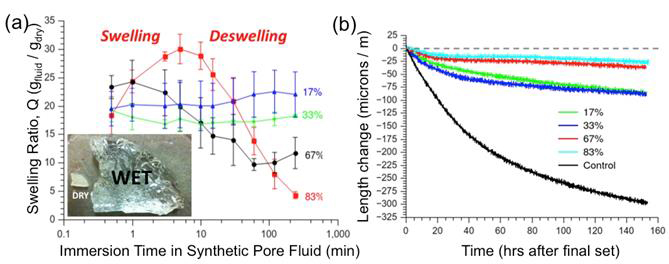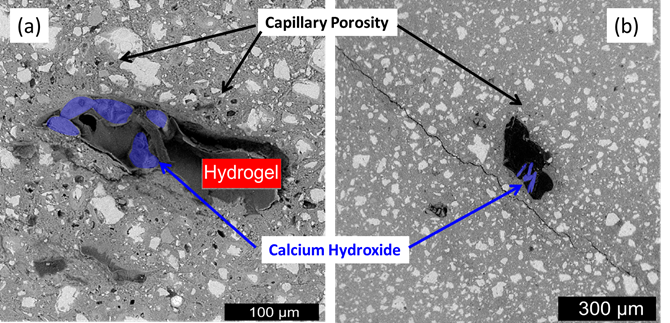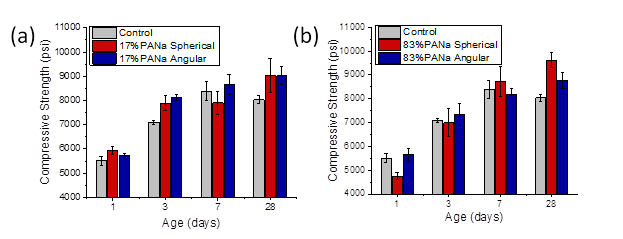Reports: DNI1054886-DNI10: Design and Characterization of Hydrogel-Based Internal Curing Agents for Oil Well Cementing Applications
Kendra A. Erk, PhD, Purdue University
Motivation and Objective: Many recent oil production disruptions are not due to the drilling or extraction process itself but instead are due to cement failure, often related to improper curing of cement oil well linings or plugs. In structural concrete applications, water-filled hydrogel-based internal curing (IC) agents are mixed into the cement paste to ensure proper hydration during curing, leading to a corresponding increase in compressive strength and durability of the final product. To extend this beneficial technology to oil well cementing applications, there is a critical need to design a new class of hydrogel-based IC agents. To address this need, the scientific objective of this research project is to identify the fundamental material structure-property-performance relationships of model polymeric hydrogels and hydrogel-cement mixtures exposed to the elevated temperatures, pressures, and ionic activity common to downhole environments. Through this work, the swelling and mechanical response of custom-synthesized superabsorbent polymer (SAP) hydrogel particles can be related to the chemical and physical macromolecular structure, the early-age hydrogel-cement mixture properties (including workability, degree of hydration, and shrinkage), and the compressive strength and microstructure of the final cured product. By developing IC agents specifically designed for oil well cementing, the risk of cement-failure due to improper curing will be significantly reduced and potentially eliminated, increasing the success and safety of oil production.
Significant Results: Acrylic-based SAP hydrogel particles were created from solution and suspension polymerization of various ratios of acrylic acid and acrylamide monomer with methylenebisacrylamide utilized as a chemical crosslinking agent. The reaction product from solution polymerization was crushed and ground, to yield irregularly shaped dry particles with a range of sizes (see Fig. 1a). Inverse suspension polymerization yielded spherical particles of similar sizes (see Fig. 1b). As IC agents, the SAP particles are incorporated into concrete mixtures in the dry state; the particles then absorb some of the free water in the mixture and swell to many times their initial dimensions. Following mixture placement, the particles will then release their stored water over time as the cement hydration reaction proceeds and water is consumed. The extra water released from the particles prevents self-desiccation of the mixture, which in turn reduces volumetric shrinkage and the formation of cracks. Following dehydration of the SAP particles, voids remain in the microstructure of the hardened concrete (see Fig. 1c and d), which have been found to beneficially increase the freeze-thaw resistance of concrete in cold-weather environments.
Figure 1: Optical micrographs of dry (unhydrated) angular (a) and spherical (b) SAP particles; SEM micrographs of the hardened microstructure of SAP-containing cement paste illustrating the voids that remain once the angular (c) and spherical (d) SAP particles were fully dehydrated.
It was recently discovered that the SAP particles absorption and desorption performance (and thus its internal curing effectiveness) is strongly sensitive to the presence of cations in the water, including K+, Na+ and Ca2+, which are naturally present in cementitious mixtures as by-products of the hydration reaction. As shown in Fig. 2a, when SAP particles are immersed in alkaline solutions designed to mimic cement pore fluid, rapid fluid absorption followed by desorption was observed for particles containing the highest concentration of acrylic acid (AA) segments in their chemical structure. Interestingly, while this fast desorption behavior was initially believed to be undesirable for internal curing, mortar containing these high-AA hydrogel particles displayed the lowest amount of shrinkage over a 7-day period (Fig. 2b) and would thus be expected to display less shrinkage-related cracking and an increased overall service life.
Figure 2: (a) Swelling behavior of SAP hydrogel particles containing 17 to 83% AA during immersion in model cement pore fluid; (b) autogenous shrinkage of mortars containing same hydrogel particles at a dosage of 0.2 % by wt. of cement. Inset of (a) shows the swelling of a dry 0.5 cm particle following immersion in pure water.
Very recent experimental results have indicated that the development of inorganic phases within the cement microstructure is dependent on the organic chemistry of the SAP particles. As displayed in Fig. 3a and b, SAP particles that displayed lower concentrations of AA in their chemical structure resulted in the formation of voids that contained a significant fraction of calcium hydroxide. Prior to these experimental findings, the construction community has long believed that SAP particles were chemically inert within concrete.
Figure 3: SEM micrographs of 7-day cured, cross-sectioned and polished cement paste samples containing calcium hydroxide formations within the void space remaining from dehydrated (a) 17% AA and (b) 33% AA SAP hydrogel particles.
Additionally, when the SAP particles were added to mortar mixtures at the typical dosage used in practice (0.2% by weight of cement), no significant strength reduction was observed in the compressive strength of the mortar (see Fig. 4) even though the SAP particles reduced the density of the mortar by introducing porosity to the microstructure. Compressive strength was also found to be independent of SAP particle shape or chemistry.
Figure 4: Compressive strength of mortar samples containing (a) 17% AA and (b) 83% AA SAP hydrogel particles. Control mortar did not contain SAP particles.
Dissemination and Impact: Results from this project have been disseminated through peer-reviewed publications and conference presentations at national meetings of the American Chemical Society, the American Concrete Institute, and the American Ceramics Society. This project has made a significant impact on the construction community by clearly demonstrating that organic chemical additives (including hydrogel-based IC agents and other admixtures) can have a significant chemical and physical impact on the final properties and performance of cementitious materials. Indeed, the findings suggest that SAP hydrogel particles can be specifically designed to improve the properties of cement, used for bridge decks and pavements as well as drilling platforms and well bore casings. Additionally, the materials engineering graduate and undergraduate students involved in this project have had deep exposure to the science and engineering related to concrete materials and the petroleum exploration and recovery progress.















